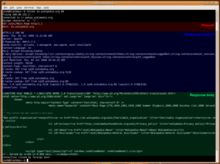HTTP协议
来源:互联网 发布:微信域名防封跳转系统 编辑:程序博客网 时间:2024/05/29 07:01
http://en.wikipedia.org/wiki/Hypertext_Transfer_Protocol
Request methods [edit]
HTTP defines methods (sometimes referred to as verbs) to indicate the desired action to be performed on the identified resource. What this resource represents, whether pre-existing data or data that is generated dynamically, depends on the implementation of the server. Often, the resource corresponds to a file or the output of an executable residing on the server.
The HTTP/1.0 specification[10]:section 8 defined the GET, POST and HEAD methods and the HTTP/1.1 specification[1]:section 9 added 5 new methods: OPTIONS, PUT, DELETE, TRACE and CONNECT. By being specified in these documents their semantics are well known and can be depended upon. Any client can use any method and the server can be configured to support any combination of methods. If a method is unknown to an intermediate it will be treated as an unsafe and non-idempotent method. There is no limit to the number of methods that can be defined and this allows for future methods to be specified without breaking existing infrastructure. For example WebDAV defined 7 new methods and RFC5789 specified the PATCH method.
- GET
- Requests a representation of the specified resource. Requests using GET should only retrieve data and should have no other effect. (This is also true of some other HTTP methods.)[1] The W3C has published guidance principles on this distinction, saying, "Web application design should be informed by the above principles, but also by the relevant limitations."[11] See safe methods below.
- HEAD
- Asks for the response identical to the one that would correspond to a GET request, but without the response body. This is useful for retrieving meta-information written in response headers, without having to transport the entire content.
- POST
- Requests that the server accept the entity enclosed in the request as a new subordinate of the web resource identified by the URI. The data POSTed might be, as examples, an annotation for existing resources; a message for a bulletin board, newsgroup, mailing list, or comment thread; a block of data that is the result of submitting a web form to a data-handling process; or an item to add to a database.[12]
- PUT
- Requests that the enclosed entity be stored under the supplied URI. If the URI refers to an already existing resource, it is modified; if the URI does not point to an existing resource, then the server can create the resource with that URI.[13]
- DELETE
- Deletes the specified resource.
- TRACE
- Echoes back the received request so that a client can see what (if any) changes or additions have been made by intermediate servers.
- OPTIONS
- Returns the HTTP methods that the server supports for specified URL. This can be used to check the functionality of a web server by requesting '*' instead of a specific resource.
- CONNECT
- Converts the request connection to a transparent TCP/IP tunnel, usually to facilitate SSL-encrypted communication (HTTPS) through an unencrypted HTTP proxy.[14][15]
- PATCH
- Is used to apply partial modifications to a resource.[16]
HTTP servers are required to implement at least the GET and HEAD methods[17] and, whenever possible, also the OPTIONS method.[citation needed]
http://en.wikipedia.org/wiki/List_of_HTTP_header_fields
Requests [edit]
Accept: text/plainAccept-CharsetCharacter sets that are acceptableAccept-Charset: utf-8Accept-EncodingAcceptable encodings. See HTTP compression.Accept-Encoding: gzip, deflateAccept-LanguageAcceptable human languages for responseAccept-Language: en-USAccept-DatetimeAcceptable version in timeAccept-Datetime: Thu, 31 May 2007 20:35:00 GMTAuthorizationAuthentication credentials for HTTP authenticationAuthorization: Basic QWxhZGRpbjpvcGVuIHNlc2FtZQ==Cache-ControlUsed to specify directives that MUST be obeyed by all caching mechanisms along the request/response chainCache-Control: no-cacheConnectionWhat type of connection the user-agent would preferConnection: keep-aliveCookiean HTTP cookie previously sent by the server with Set-Cookie (below)Cookie: $Version=1; Skin=new;Content-LengthThe length of the request body in octets (8-bit bytes)Content-Length: 348Content-MD5A Base64-encoded binary MD5 sum of the content of the request bodyContent-MD5: Q2hlY2sgSW50ZWdyaXR5IQ==Content-TypeThe MIME type of the body of the request (used with POST and PUT requests)Content-Type: application/x-www-form-urlencodedDateThe date and time that the message was sentDate: Tue, 15 Nov 1994 08:12:31 GMTExpectIndicates that particular server behaviors are required by the clientExpect: 100-continueFromThe email address of the user making the requestFrom: user@example.comHostThe domain name of the server (for virtual hosting), and the TCP port number on which the server is listening. The port number may be omitted if the port is the standard port for the service requested.[5] Mandatory since HTTP/1.1. Although domain name are specified as case-insensitive,[6][7]it is not specified whether the contents of the Host field should be interpreted in a case-insensitive manner[8] and in practice some implementations of virtual hosting interpret the contents of the Host field in a case-sensitive manner.[citation needed]Host: en.wikipedia.org:80Host: en.wikipedia.org
If-Match: "737060cd8c284d8af7ad3082f209582d"If-Modified-SinceAllows a 304 Not Modified to be returned if content is unchangedIf-Modified-Since: Sat, 29 Oct 1994 19:43:31 GMTIf-None-MatchAllows a 304 Not Modified to be returned if content is unchanged, see HTTP ETagIf-None-Match: "737060cd8c284d8af7ad3082f209582d"If-RangeIf the entity is unchanged, send me the part(s) that I am missing; otherwise, send me the entire new entityIf-Range: "737060cd8c284d8af7ad3082f209582d"If-Unmodified-SinceOnly send the response if the entity has not been modified since a specific time.If-Unmodified-Since: Sat, 29 Oct 1994 19:43:31 GMTMax-ForwardsLimit the number of times the message can be forwarded through proxies or gateways.Max-Forwards: 10OriginInitiates a request for cross-origin resource sharing (asks server for an 'Access-Control-Allow-Origin' response header) .Origin: http://www.example-social-network.comPragmaImplementation-specific headers that may have various effects anywhere along the request-response chain.Pragma: no-cacheProxy-AuthorizationAuthorization credentials for connecting to a proxy.Proxy-Authorization: Basic QWxhZGRpbjpvcGVuIHNlc2FtZQ==RangeRequest only part of an entity. Bytes are numbered from 0.Range: bytes=500-999Referer[sic]This is the address of the previous web page from which a link to the currently requested page was followed. (The word “referrer” is misspelled in the RFC as well as in most implementations.)Referer: http://en.wikipedia.org/wiki/Main_PageTEThe transfer encodings the user agent is willing to accept: the same values as for the response header Transfer-Encoding can be used, plus the "trailers" value (related to the "chunked" transfer method) to notify the server it expects to receive additional headers (the trailers) after the last, zero-sized, chunk.TE: trailers, deflateUpgradeAsk the server to upgrade to another protocol.Upgrade: HTTP/2.0, SHTTP/1.3, IRC/6.9, RTA/x11User-AgentThe user agent string of the user agentUser-Agent: Mozilla/5.0 (X11; Linux x86_64; rv:12.0) Gecko/20100101 Firefox/12.0ViaInforms the server of proxies through which the request was sent.Via: 1.0 fred, 1.1 example.com (Apache/1.1)WarningA general warning about possible problems with the entity body.Warning: 199 Miscellaneous warningCommon non-standard request headers [edit]
Non-standard header fields were conventionally marked by prefixing the field name with X- .[9] However, this convention became deprecated in June 2012 due to the inconveniences it caused when non-standard headers then became standard.[10] For example, X-Gzip and Gzip are now both supported headers for compressed HTTP requests and responses.
XMLHttpRequestX-Requested-With: XMLHttpRequestDNT[11]Requests a web application to disable their tracking of a user. This is Mozilla's version of the X-Do-Not-Track header (since Firefox 4.0 Beta 11). Safari and IE9 also have support for this header.[12] On March 7, 2011, a draft proposal was submitted to IETF.[13] The W3C Tracking Protection Working Group is producing a specification.[14]DNT: 1 (Do Not Track Enabled)DNT: 0 (Do Not Track Disabled)
X-Forwarded-For: client1, proxy1, proxy2X-Forwarded-For: 129.78.138.66, 129.78.64.103
X-Forwarded-Proto: httpsFront-End-Https[17]Non-standard header used by Microsoft applications and load-balancersFront-End-Https: onX-ATT-DeviceId[18]Allows easier parsing of the MakeModel/Firmware that is usually found in the User-Agent String of AT&T Devicesx-att-deviceid: MakeModel/FirmwareX-Wap-Profile[19]Links to an XML file on the Internet with a full description and details about the device currently connecting. In the example to the right is an XML file for an AT&T Samsung Galaxy S2.x-wap-profile:http://wap.samsungmobile.com/uaprof/SGH-I777.xmlProxy-Connection[20]Implemented as a misunderstanding of the HTTP specifications. Common because of mistakes in implementations of early HTTP versions. Has exactly the same functionality as standard Connection header.Proxy-Connection: keep-aliveResponses [edit]
Access-Control-Allow-Origin: *Accept-RangesWhat partial content range types this server supportsAccept-Ranges: bytesAgeThe age the object has been in a proxy cache in secondsAge: 12AllowValid actions for a specified resource. To be used for a 405 Method not allowedAllow: GET, HEADCache-ControlTells all caching mechanisms from server to client whether they may cache this object. It is measured in secondsCache-Control: max-age=3600ConnectionOptions that are desired for the connection[21]Connection: closeContent-EncodingThe type of encoding used on the data. See HTTP compression.Content-Encoding: gzipContent-LanguageThe language the content is inContent-Language: daContent-LengthThe length of the response body in octets (8-bit bytes)Content-Length: 348Content-LocationAn alternate location for the returned dataContent-Location: /index.htmContent-MD5A Base64-encoded binary MD5 sum of the content of the responseContent-MD5: Q2hlY2sgSW50ZWdyaXR5IQ==Content-Disposition[22][23][24]An opportunity to raise a "File Download" dialogue box for a known MIME type with binary format or suggest a filename for dynamic content. Quotes are necessary with special characters.Content-Disposition: attachment; filename="fname.ext"Content-RangeWhere in a full body message this partial message belongsContent-Range: bytes 21010-47021/47022Content-TypeThe MIME type of this contentContent-Type: text/html; charset=utf-8DateThe date and time that the message was sentDate: Tue, 15 Nov 1994 08:12:31 GMTETagAn identifier for a specific version of a resource, often a message digestETag: "737060cd8c284d8af7ad3082f209582d"ExpiresGives the date/time after which the response is considered staleExpires: Thu, 01 Dec 1994 16:00:00 GMTLast-ModifiedThe last modified date for the requested object, in RFC 2822 formatLast-Modified: Tue, 15 Nov 1994 12:45:26 GMTLinkUsed to express a typed relationship with another resource, where the relation type is defined by RFC 5988Link: </feed>; rel="alternate"[25]LocationUsed in redirection, or when a new resource has been created.Location: http://www.w3.org/pub/WWW/People.htmlP3PThis header is supposed to set P3P policy, in the form ofP3P:CP="your_compact_policy". However, P3P did not take off,[26] most browsers have never fully implemented it, a lot of websites set this header with fake policy text, that was enough to fool browsers the existence of P3P policy and grant permissions for third party cookies.P3P: CP="This is not a P3P policy! See http://www.google.com/support/accounts/bin/answer.py?hl=en&answer=151657 for more info."PragmaImplementation-specific headers that may have various effects anywhere along the request-response chain.Pragma: no-cacheProxy-AuthenticateRequest authentication to access the proxy.Proxy-Authenticate: BasicRefreshUsed in redirection, or when a new resource has been created. This refresh redirects after 5 seconds. This is a proprietary, non-standard header extension introduced by Netscape and supported by most web browsers.Refresh: 5; url=http://www.w3.org/pub/WWW/People.htmlRetry-AfterIf an entity is temporarily unavailable, this instructs the client to try again after a specified period of time (seconds).Retry-After: 120ServerA name for the serverServer: Apache/2.4.1 (Unix)Set-CookieAn HTTP cookieSet-Cookie: UserID=JohnDoe; Max-Age=3600; Version=1StatusThe HTTP status of the responseStatus: 200 OKStrict-Transport-SecurityA HSTS Policy informing the HTTP client how long to cache the HTTPS only policy and whether this applies to subdomains.Strict-Transport-Security: max-age=16070400; includeSubDomainsTrailerThe Trailer general field value indicates that the given set of header fields is present in the trailer of a message encoded with chunked transfer-coding.Trailer: Max-ForwardsTransfer-EncodingThe form of encoding used to safely transfer the entity to the user. Currently defined methods are: chunked, compress, deflate, gzip, identity.Transfer-Encoding: chunkedVaryTells downstream proxies how to match future request headers to decide whether the cached response can be used rather than requesting a fresh one from the origin server.Vary: *ViaInforms the client of proxies through which the response was sent.Via: 1.0 fred, 1.1 example.com (Apache/1.1)WarningA general warning about possible problems with the entity body.Warning: 199 Miscellaneous warningWWW-AuthenticateIndicates the authentication scheme that should be used to access the requested entity.WWW-Authenticate: BasicCommon non-standard response headers [edit]
Non-standard header fields are conventionally marked by prefixing the field name with X- .
X-Frame-Options: denyX-XSS-Protection[28]Cross-site scripting (XSS) filterX-XSS-Protection: 1; mode=blockContent-Security-Policy, X-Content-Security-Policy, X-WebKit-CSP[29]Content Security Policy definition.X-WebKit-CSP: default-src 'self'X-Content-Type-Options[30]The only defined value, "nosniff", prevents Internet Explorer from MIME-sniffing a response away from the declared content-type. This also applies to Google Chrome, when downloading extensions.[31]X-Content-Type-Options: nosniffX-Powered-By[32]specifies the technology (e.g. ASP.NET, PHP, JBoss) supporting the web application (version details are often in X-Runtime, X-Version, or X-AspNet-Version)X-Powered-By: PHP/5.4.0X-UA-Compatible[33]Recommends the preferred rendering engine (often a backward-compatibility mode) to use to display the content. Also used to activate Chrome Frame in Internet Explorer.X-UA-Compatible: IE=EmulateIE7X-UA-Compatible: IE=edgeX-UA-Compatible: Chrome=1用Wireshark抓包:
- HTTP协议
- http协议
- HTTP协议
- HTTP协议
- HTTP协议
- http协议
- HTTP协议
- HTTP协议
- HTTP协议。。。
- HTTP协议
- HTTP协议
- HTTP协议
- HTTP协议
- HTTP协议
- http协议
- HTTP协议
- http协议
- HTTP协议
- 阿里80亿贷款细节曝光 并购背后图谋大数据
- webclient在访问期间出现 异常,报错! 无法发送具有此谓词类型的内容正文。
- 你所应该知道的Android设计
- Android 中的 Service 全面总结
- 阻塞和非阻塞
- HTTP协议
- AMD推出Temash APU处理器 进军平板市场
- Mac OS 如何在终端下打开 APP 应用程序?
- Winter framework 高效灵活的请求处理框架
- 【堆栈】POJ2082-Terrible Sets-【容易题】
- sqlite3使用简介
- 霍夫圆检测的matlab实现
- vhdl 变量与信号区别 type符号使用
- asp.net 前台jquery利用ajax 调用后台方法










